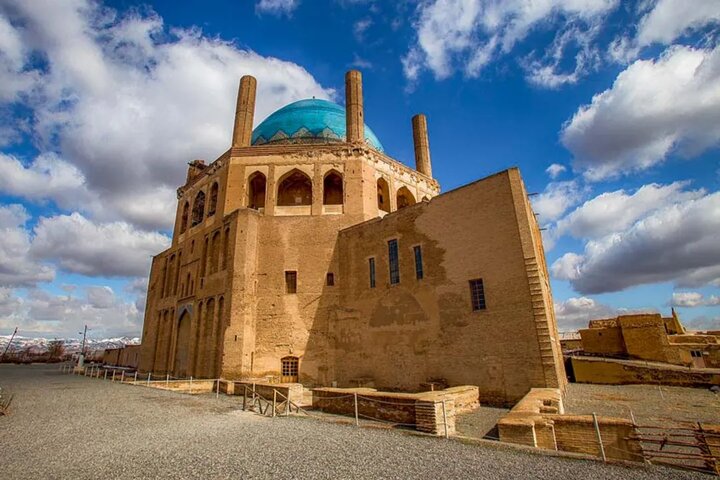Royal Ilkhanid cemetery unearthed near UNESCO-listed Soltaniyeh Dome

TEHRAN – Archaeologists have uncovered parts of a royal Ilkhanid cemetery adjacent to the UNESCO-listed Soltaniyeh Dome in west-central Iran, the head of the excavation team said on Sunday.
Abolfazl AAli, who also manages the Soltaniyeh World Heritage site, said the discovery was made during excavations in an area known as Abwab al-Berr, revealing sections of an underground tomb.
“Based on existing evidence, historical texts, and the skeletons found, the burial site likely belongs to members of the Mongol Ilkhanid royal family,” AAli said.
He said the cemetery may have been the resting place of some relatives of Oljaytu, the eighth Ilkhanid ruler, including one of his wives and children, as recorded in historical accounts.
Archaeologists say royal cemeteries can provide information on social hierarchy and the status of individuals in past societies. The way the dead were buried and the objects buried with them can offer insights into the beliefs and religious practices of the period, AAli explained.
The excavation, which began in early August in the south-western section of the Soltaniyeh citadel, is expected to continue until late September. Items typically found in such burials include human remains, valuable objects, architectural structures, and inscriptions.
The Soltaniyeh Dome, built in the 14th century by Sultan Mohammad Khodabandeh (Oljaytu), is the world’s largest brick dome and a major tourist attraction in Zanjan province. Recognized for its innovative double-shell structure and intricate turquoise tilework, it is considered a masterpiece of Islamic architecture.
The city of Soltaniyeh served briefly as the capital of Persia’s Ilkhanid dynasty, a branch of the Mongol Empire, and is regarded by UNESCO as a key link in the development of Islamic architecture in Central and Western Asia.
According to UNESCO, the mausoleum’s interior decoration is so outstanding that scholars like A.U. Pope have described the building as “anticipating the Taj Mahal”.

The dome is embellished with turquoise-blue faience tiles, the stunning structure dominates the skyline of Soltaniyeh, an ancient city of the same name in Zanjan province, north-western Iran. It rises dramatically 48m above from its base that neighbors dusty archaeological digs and crumbling walls.
UNESCO says that the Mausoleum of Oljaytu is an essential link and key monument in the development of Islamic architecture in central and western Asia.
The fairly large dome is the earliest extant example of its type in the country, and became an important reference for the later development of the Islamic dome.
Also, the extremely rich interior of the mausoleum, which includes elaborate brickwork, glazed tiles, marquetry or designs in inlaid materials, stucco, and frescoes, can be conceived as a masterpiece in the arena of Islamic architecture.
Ilkhanid dynasty
The Ilkhanid dynasty, also called Il-Khanid, was a Mongol dynasty that ruled Iran from 1256 to 1335. Il-Khan is Persian for "subordinate khan".
Hulegu, a grandson of Genghis Khan, received orders from the supreme Mongol chieftain Mongke to conquer Iran. Hulegu set out around 1253 with a Mongol army of about 130,000 men. He founded the Il-Khanid dynasty in 1256 and conquered Baghdad and all of Iran by 1258, according to Britannica.
The Il-Khanids consolidated their position in Iran and unified the region as a political and territorial entity after several centuries of fragmented rule by small dynasties. During the reign of the Il-Khanid Maumud Ghuzun (r. 1295-1304), the Il-Khanids lost all contact with the remaining Mongol chiefs in China. Mahmud Ghuzun himself embraced Sunni Islam, and his reign was a time of Iranian cultural renaissance in Iran, with scholars such as Rashid al-Din flourishing under his patronage.
Ghazan's brother Oljeitu (r. 1304-16) converted to Shia Islam in 1310. Oljeitu's conversion caused great unrest, and when he died in 1316, the civil war was imminent. His son and successor, Abu Sa'id (r. 1317-35), converted to Sunni Islam and was thus able to prevent a war.
During Abu Sa'id's reign, however, factional disputes and internal unrest continued to spread. Abu Sa'id died without leaving an heir, and with his death, the unity of the dynasty was broken. Thereafter, various Il-Khanid princes ruled parts of the dynasty's former territory until 1353.
AM
